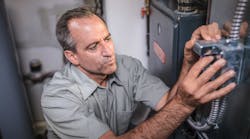When it comes to comfort, efficiency, and environmental impact, high-efficiency propane-powered furnaces consistently outperform electric systems, providing benefits that simply can’t be matched.
With that being said, misinformation about high-efficiency propane furnaces — and how they stack up against other energy systems — still exists.
The following are five myths that surround propane furnaces and the facts that HVACR contractors need to know:
MYTH: High-efficiency propane furnaces perform comparable to electric heat pumps.
FACT: There are key differences in costs and performance.
Construction professionals should consider the three C’s of a propane furnace — cost, comfort, and carbon — when determining the key differences between a high-efficiency propane furnace and other energy sources.
Contractors can sell homeowners on a propane furnace’s ability to provide warmer delivery air and a reduction of carbon emissions. When compared with heat pumps, high-efficiency propane furnaces produced 35 percent fewer carbon emissions for new homes in the Midwest.
In addition, high-efficiency propane furnaces are one of the safest, most versatile options for heating a home.
MYTH: Cost savings for high-efficiency propane furnaces are nominal.
FACT: Homeowners can see substantial annual savings due to propane furnaces’ high-efficiency ratings.
Non-weatherized gas furnaces are 80 AFUE (80 percent efficiency) at minimum and new electric furnaces are still allowed to be as low as 78 AFUE. And without regular maintenance, they can lose up to one percent efficiency each year. That loss in efficiency can add up fast for your customers.
High-efficiency propane furnaces, however, are rated anywhere between 90 and 98 percent efficient. Their increased efficiency can mean substantial savings in a homeowner’s annual energy bill.
MYTH: Homes in warmer climates don’t benefit from high-efficiency propane furnaces.
FACT: Propane furnaces deliver a more comfortable heat in any climate.
A recent study from PERC titled “A Comparative Analysis of Residential Heating Systems,” found that in home simulations, propane-forced air furnaces typically provide warmer heat than homes with heat pumps, which is likely to be perceived as more comfortable for those living in the home.
In a mixed climate, warmer outdoor temperatures provide some relief in terms of delivering higher temperatures indoors, but the supply air from the air-source heat pump (ASHP) still feels “cool” for the majority of the heating season.
In these climates, propane is often used as a back-up system in tandem with an ASHP to deliver warmer heat when needed.
MYTH: First costs with high-efficiency propane furnaces are too high.
FACT: First costs of high-efficiency propane furnaces are the same, if not lower than, less-efficient systems.
Although a high-efficiency propane furnace will be at least 90 percent efficient and can lower utility bills and enhance comfort, many homeowners pay the most attention to the initial cost.
The total installation cost of a high-efficiency propane furnace is often lower than, or equal to, less efficient furnaces (i.e., 80 AFUE models), or standard efficiency ASHPs. A key cost-saving feature of the high-efficiency propane furnace is its ability to use a plastic vent pipe. Simpler and more affordable to install, the single pipe contains an inner exhaust vent and an outer intake vent for the air used in the propane furnace’s combustion. This allows installers to make just one penetration through the building shell to the outdoors. And since it’s typically plastic, rather than metal, the pipe stays cool-to-the-touch.
MYTH: The energy savings never catch up to the first costs.
FACT: Energy savings win out and enable long-term savings.
According to the PERC study, a high-efficiency propane furnace has annual energy costs of about $1,650 for a new home in a cold climate, nearly 10 percent lower than the standard-efficiency ASHP and 14 percent lower than the heating oil furnace.
In addition, a high-efficiency propane furnace in an existing home in the cold or mixed climate zone has an average payback period of two years compared to installing a standard 80 percent efficient furnace, when the furnace’s first cost and annual energy cost are factored in. The average lifespan of a high-efficiency propane furnace is approximately 16 to 20 years.
High-efficiency propane furnaces are worth considering, especially for mindful industry professionals, and the homeowners they serve, interested in improving their property’s carbon footprint. Not only can they provide energy, cost, and carbon savings in both new and existing homes, but they also deliver a higher level of comfort to today’s homeowners. Visit buildwithpropane.com to learn more about the benefits of propane-powered furnaces.
Jesse Marcus is the director of residential and commercial business development at the Propane Education & Research Council. He can be contacted at [email protected].









